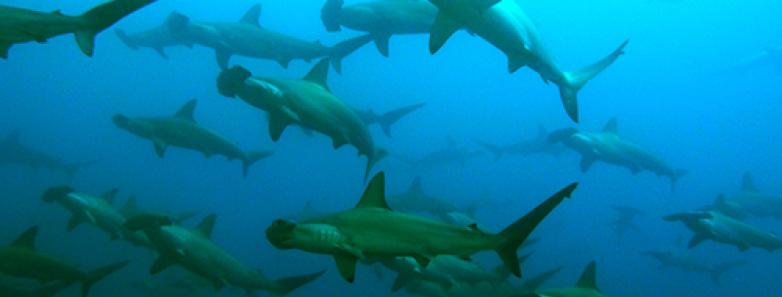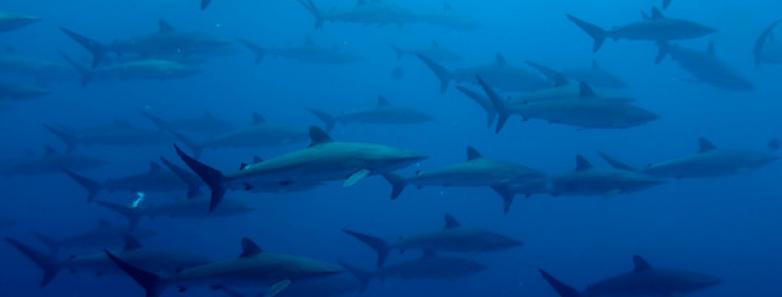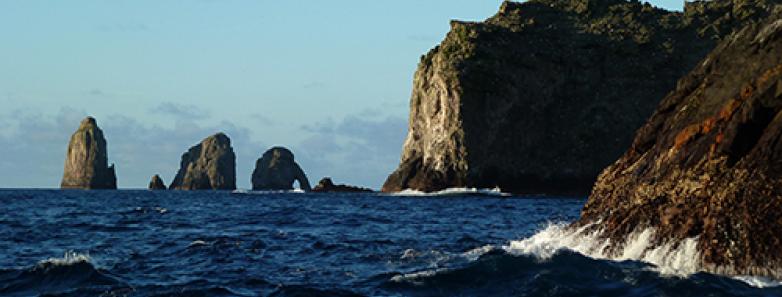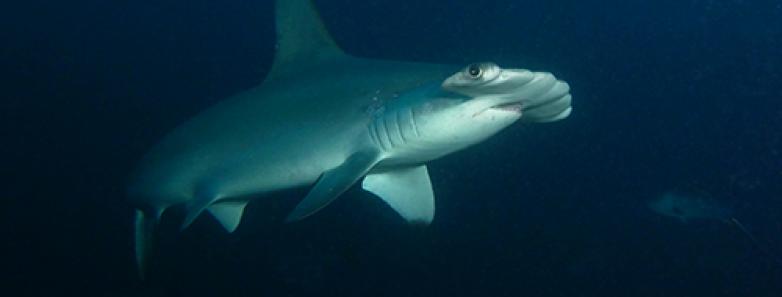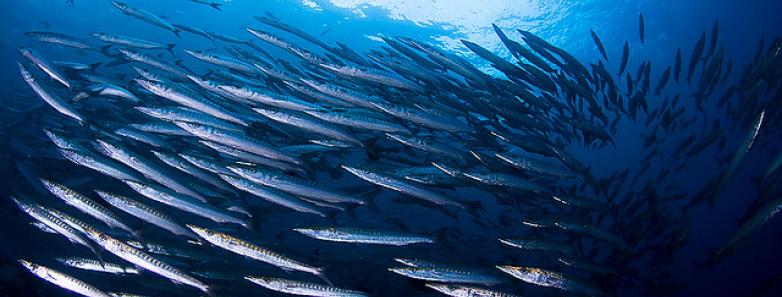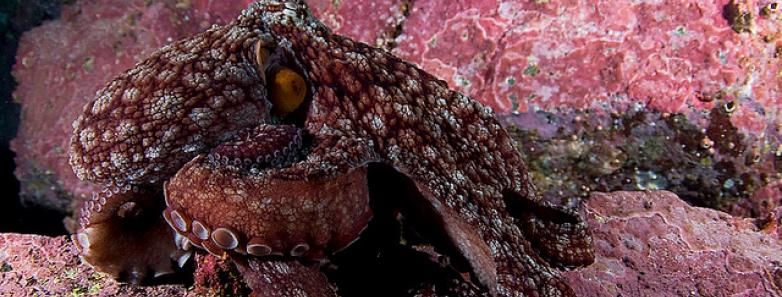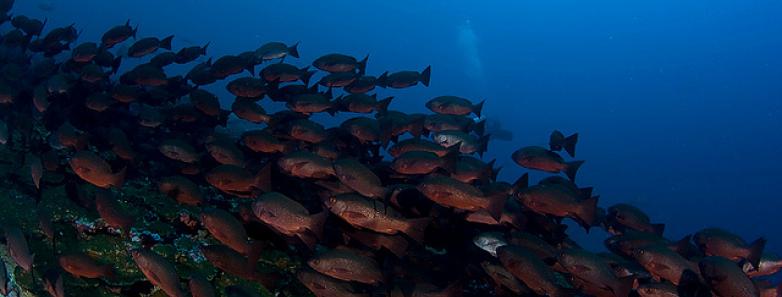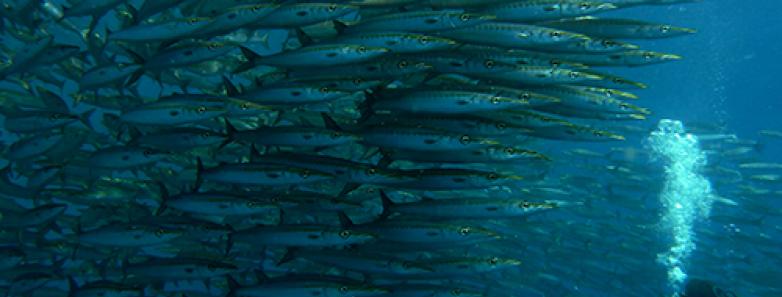Scuba Diving in Malpelo Island, Colombia
View Location on Google Map
Malpelo Island diving highlights
Malpelo Island, or the Malpelo Fauna and Flora Sanctuary, lying over 300 miles off the coast of Columbia, is unique to other islands in the Eastern Pacific. First of all, it is only eight square kilometers. Barren and nearly vertical cliffs of the island expose the summit of the three-hundred-kilometer-long volcanic ridge rising from the ocean floor at a depth of nearly 3 kilometers.
With such a small island size and the entire ocean abyss encircling, the concentration of pelagic life in Malpelo waters is enormous. Scuba diving in Galapagos and Socorro (Revillagigedo) archipelagos pale in comparison. Even Cocos Island, solitary but still a larger island, does not have the geological advantage of Malpelo. Malpelo was designated a UNESCO World Heritage Site in 2006.
At Cocos, divers have to visit deep-water pinnacles located well away from the main island to admire schooling hammerheads. At Malpelo, sharks are abundant near the island itself and as a result, hammerheads are often encountered in very shallow waters.
The advantage for a photographer is obvious – more chances to run into your model and more bottom time to take advantage of the opportunity. Another advantage for Malpelo divers is provided by the Colombian government, not nature. Access to Malpelo is very limited. As of writing this article, only five liveaboards are permitted to go to the island and only one boat with a max of 16 divers is allowed per day. The presence of small Colombian marine outpost and the very short wide open shoreline of the island help keep away the poachers. 2019 Update: There is only one dive liveaboard operating in Malpelo at the time of this update, the Ferox.
Jump to:
Dive Overview - Marine Life - Top Dive Spots
THE MALPELO REGION - 4 DIFFERENT CURRENTS
The Tropical Eastern Pacific is unsurpassed for interactions with big marine life. The west coast of both North & South America is washed by two grand oceanic currents: the California Current from the North and the mirroring Humboldt Current from the South, which makes the west coast a classic upwelling zone. Near the Equator, the collision of two gigantic streams is further mixed with another upwelling produced by the stable, low-pressure system of the Tropical Convergence Zone – the place where the ever-in-zenith sun heats the air, and easterly trade winds of the Northern and Southern hemispheres converge into high-towering clouds and thunderstorms.
Strong ocean upwelling feeds a huge pyramid of marine life, and there is no better place on Earth to see the top of that mighty pyramid than the remote volcanic islands of the Tropical Eastern Pacific. You should keep in mind that a combination of surge, strong currents, and a remote location can make this a challenging destination, but when conditions are right it is the best in its class and is one of the world's best shark dives.
Diving Information
Diving in Malpelo
Unbelievable, period. The best way to describe Malpelo is not through individual stories about individual dive sites, because Malpelo is one big dive site. You can encounter many animals pretty much anywhere around the island. We're talking about a genuinely wild place and truly wild animals. No sitings are guaranteed, but the chances of unique encounters are very, very good. If your first trip is Malpelo, you will have serious problems finding your next destination. Most other places will look dull and boring. That is how some divers feel after diving Cocos, and how many feel after Malpelo.
To dive at Malpelo, you should have at minimum AOW certification and have experience with dive 60-130ft. You should also be comfortable with your ability to handle strong current, surge, high swells and live entries to an immediate negative descent. This is because most of the dive sites do not allow for anchorage or moorings, and many of them are small underwater pinnacles. With the speed of the currents in the area, if you linger at the surface to tinker with your gear, or if you have equalization problems that slow your descent, you will likely get blown off the dive site and end up drifting in open water until the skiff can retrieve you. The group cannot split to wait for you in that current. Nitrox is also a must as dive groups must descend and ascend together, so you if your group is on nitrox you will need to be as well. On top of that, Eastern Pacific diving without nitrox is just not a good use of hard-earned money since there is so much to see on every dive. if you don't have your nitrox certification before your trip, let the liveaboard know and they can arrange to certify you onboard.
In open ocean diving your safety sausage should be big - about six feet. A smaller one might be obscured by the waves, and once deployed your next stop might be Australia.
Overall, you also need to stay very conservative in Malpelo because the nearest decompression chamber does not exist - plain and simple.
For your dive gear, you'll want fins that perform well in currents and the rest of your gear to be as streamlined as possible. Some divers have recommended long stiff fins like the Cressi Gara, which are clumsy in the panga but indispensable in currents. Whale sharks do not pose for photos so you'll need to exert a lot of effort in swimming next to them.
Since there is not much coral around, damaging the reef with long fins is not a huge concern, but divers should still be aware of sea life around them. When diving shallows near the wall, divers shouldn't brace themselves against the rocks. In high swells, it is safer (and more fun) to move with the water. The same rule applies when taking photos in the grotto - do not grab the rocks. There are plenty of nasty eels in Malpelo. Free swimming morays are a trademark at Malpelo and lots of fun to watch.
For exposure protection, a 7mm wetsuit, hood and gloves are recommended. Though surface water temps can reach the 70s (F), below the shallow thermocline the temperature can quickly drop. Drysuits are discouraged due to the additional drag in currents and surge.
Malpelo Island photography subjects
There are many different fish species in Malpelo, but don’t be entirely absorbed by the reef. You can admire Pacific fish in other places on much cheaper dive trips. Look into the blue. The most interesting stuff swims in from the open water. Beware though - if you look for too long to the right, you are surely missing something on the left.
Look for thermocline. Large sharks huddle there. If the shark is below you, never swim towards it as it will dodge deeper. Wait. Sharks circle around and will probably come back towards you. Whale sharks are an exception.
For hammerheads, the dive guides advised that it's best to tuck down and essentially try to camouflage yourself as part of the rocky reef near the cleaning stations. If you swim towards the sharks or are up floating above the reef they tend to avoid you.
Also, keep in mind that hammerheads fear strobe flash. If one comes toward you, remember that you have a single photo opportunity. Wait patiently for the best photo opportunity.
For compact shooters, having a wide-angle or fisheye lens will be great in situations where you are able to get closer to subjects, however, if you are finding the sharks aren't coming close enough for portraits, you may be better off using the native lens on the camera.
If you are shooting with a mirrorless or DSLR camera, a wide-angle zoom lens is recommended for most shark photography at Malpelo. The full 180-degree view on a lens like the Tokina 10-17mm fisheye can be too wide for most of the interactions, since these are natural encounters and the sharks are not guaranteed to come close.
Try using your strobes on low power if the sharks are coming close enough for the light to make a difference, adding a little light and color without blowing out their white underbellies. If the sharks are further back then stick with ambient light or try shooting video instead.
Irrespective of camera type, keep an eye on the thermocline not just for spotting sharks, but because it can and will affect your photos and video. The thermocline often moves shallower and deeper during a single dive within the 40-80ft range. It can be the cause of much frustration for all photographers because if the sharks happen to be above the thermocline and you are below it, all of your shots will appear blurred.
Marine Life
Typically, on a trip, you should see hammerhead sharks, silky sharks, large schools of fish, eagle rays, Galapagos sharks, free-swimming eels, dolphins and whale sharks or mantas. Humpback whales often make appearances.
- Hammerhead sharks
- Malpelo is known for very large numbers of hammerhead sharks. The sharks here often come shallower than the sharks do in Cocos, especially during the cooler winter months. The cleaning station is the place to be when a school of hammerheads is nearby. Approaching the school will get you deeper and you will lose time and light. The school is best watched from the side, and at the cleaning station, large singles will often swim within hand distance. Patience is key in order to get close to the sharks. Fish are your key to finding cleaning stations. Besides the regular barber-fish, there are two other cleaners in Malpelo, Clarion angelfish and juvenile rainbow wrasse. Get to know them. Blackjacks often accompany whale sharks and seem to be hitting the shark sidewise, which is another form of cleaning.
- Manta Rays
- Big mantas here are not as abundant as in Socorro but they do show up. Watch for rocky outcrops in the current, since these create an upward water flow. Mantas are heavy and love those upward currents. A common misconception is that bubbles scare away pelagic fish, but actually it's the direction of your movement that causes fish to flee. If there is large pelagic nearby, ascend slowly, moving away from the fish and it will come closer. This trick works as long as you avoid the eye contact. If the current is manageable, ask the DM to end the dive by ascending in open water. There might be interesting encounters with pelagics away from the island. If you end the dive near the wall, pay attention to the foamy surge and you might be surprised with what you see.
For anothr fantastic big fish destination, check out our Sipadan dive guide.
UNDERWATER PHOTOGRAPHY
Most subjects are big animals, I suggest a wide-angle lens - see the best lenses here. If you have a compact camera, check out the Nauticam WWL-C. For dSLR shooters, a wide-angle zoom will give you a little reach for shy sharks.
Best Dive Sites IN MALPELO
To give you some sense of the range of dive sites, here are some brief descriptions:
- 1. La Nevera "The Fridge": This is the cleaning station site where schools of scalloped hammerheads and smaller groups of Galapagos sharks visit to be cleaned by the abundant fish. Moray eels are also very common here. The reef itself is very stark, consisting of mostly rock with some urchins. But don't let that fool you - this is as close to guaranteed shark sightings as you can get in Malpelo.
- 2. El Altair de Virginia: Also a great site for hammerhead shark sightings as well as multiple eagle rays. There was more color at this site with some hard corals and many fish. Small whitetip reef sharks were spotted here on consecutive dive days patrolling close to the reef and diving under formations to rest in the sand.
- 3. La Ferreteria: Small underwater pinnacle off the southern end of Malpelo Island. At the time of writing, the Yemaya is the only liveaboard with permission to dive this site. We were escorted by dolphins while heading to the site, which is representative of the sheer density of marine life found here: multiple eels sharing one crevice, multiple large scorpionfish stacked on top of one another and more surprises. Currents are very strong, so you need to be careful not to get blown off the pinnacle or get pushed into it and cause damage.
- 4. La Cathedral: This site is off the northern end of Malpelo Island and features a large passthrough cave. Large schools of fish, including bigeye trevally jacks, are frequently spotted here.
- 5. Bajo Del Monstruo: This is a pinnacle off the northern end of the island, which can only be dived in good conditions. It's known as a fish spot although sharks can also be spotted. Huge schools of leather bass and creole fish navigate the strong currents. On the sides of the pinnacle where there is less current, the structure is entirely covered with delicate yellow-orange anemones, so you must take care not to cause accidental damage.
- 6. La Cara del Fantasma: Near El Altair de Virginia, Fantasma is a wonderful site where you can see large schools of fish like blue and gold snappers, whitetip reef sharks and hammerheads, while schooling pacific barracuda often frequent the site.
- 7. La Gringa: This site lies off the southern end of the island, with its most notable featuring being a large cave with fish living inside.
- 8. El Acquario: One of the coldest sites at Malpelo. The underwater pinnacle has diverse fish life and frequently gets hit with strong currents.
Travel Information
How to Get There & How to Dive Malpelo
You must go via liveaboard. Liveaboards leave either from Panama or Columbia, and take about 32-35 hours to get there from Panama. If you go from Panama, you fly into Panama City, and there are many international flights available. It is best to arrive a little early, because if your luggage doesn't make it, it can be very difficult to get it to you.
3 dives a day are done in Malpelo - usually two in the morning and 3rd in the afternoon. There are no night dives. Safety is key because a diver lost in the current could be carried far away. Divers typically go to the dive sites in skiffs or pangas, and since the island is only about 1 mile long, the sites are all within a short 10-minute boat ride from your liveaboard.
2019 Update: There is only one dive liveaboard operating in Malpelo, the Ferox.
Best Time to Dive
The winter is a sunny and windy dry season while summer is calm and rainy. Summer is generally considered the high season but there is no guarantee in the Eastern Pacific. Thermocline and visibility can change fast and dramatically. Even in high season you are better off with your luck than with the weather forecast.
The best time to go really depends on what you want to see. Hammerheads and Galapagos sharks are spotted pretty much year-round but will vary in density. Whale sharks and giant mantas are possible to see in the summer, and large schools of silky sharks and bait balls tend to be around the island from April-July. If you want to see all of these animals, June and July are the best months. if you're aiming to see the largest schools of hammerheads, December is your best bet.
The water is quite cold during January-March (16-18 Celcius below the shallow thermocline), warming up to 28 Celsius in July-August, still with the possibility of thermoclines.
Topside & Non-Diving Activities
There is not much to do other than diving, but visitors can also see the birds and enjoy the stunning views.
Other Useful Information
Practical Information
- Currency: Colombian Peso (COP)
- Electricity: 110 volts
- Language: Spanish
- Time Zone: UTC-5
GOT QUESTIONS? READY TO BOOK?
Call us today at +1-310-915-6677 or email us info@bluewaterdivetravel.com
And let us book your dream vacation!

